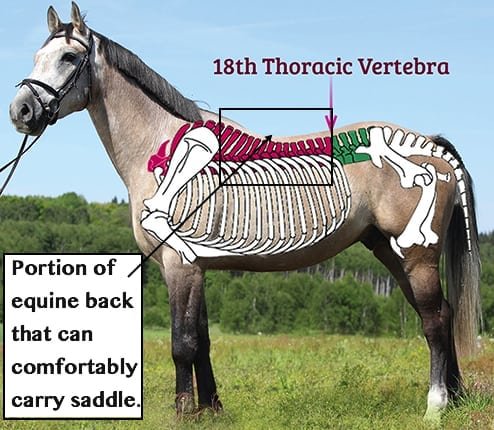Top 5 Saddle Fitting Mistakes
I wanted to do a quick rundown of the top 5 saddle fitting errors or issues that I run into when consulting on saddle fit. First of all, the symptoms I have listed can have other causes. But if your horse is exhibiting them the saddle is worth looking at.
1 – Tree Angle Incorrect
A tree angle being too wide or tree width too narrow is the most common saddle fit error. Most importantly: wider is NOT always better. As a result it can cause focal pressure on the withers. Symptoms: girthiness/cinchiness, grinding teeth, tossing head, irregularity in front, hollow back, inverted neck, sacrum out of alignment, white hairs. To learn more about tree angle, check out this post.
2 – Bridging Saddle
A bridging saddle is a saddle that only touches in the front and back. It does not carry through the middle of the horse’s back.
This can result in or cause a severely sore back. It can also shut down the front end and hind end of the horse.
Symptoms: Dry patches front and back, hollow back, back becoming more swayed, sore back, bucking and dips in back muscle.
Learn more about bridging saddles in this post.
3 - Too Narrow Gullet
The gullet width is the space between the panels in an English saddle or width between the tree bars in a Western saddle. The gullet being too narrow impinges on the spine and stabilization muscles of the equine back. Symptoms: Irregular gait all four legs, tossing head, inverted back, hollowing of back muscles, stiffness, chiropractic misalignments. Learn more about gullet width in this post.
4 – Saddle Too Long
When the saddle extends back past the end of the rib cage it rests on the lumbar spine. THERE IS NO WAY TO MAKE A GULLET/TREE WIDE ENOUGH TO AVOID THE SPINE BEHIND THE RIBCAGE. If the saddle goes off the end of the ribs it will interact with the lumbar and cause low back pain. Symptoms: Bucking, cross cantering, refusal to canter, bolting, parking behind at halt, sore lower back. Learn more about saddle length in this post.
5 – Incorrect Girth/Cinch Alignment
Your girth or cinch is how your saddle attaches to your horse. The billets or rigging on your saddle should line up with your horse’s specific girth area. If not, it can cause saddle to shift and move. Symptoms: Girth galls, saddle bouncing, saddle slides forward, saddle slides back. Learn more about girth placement in this post.
In conclusion, I hope these 5 saddle tips can help you to diagnose if your saddle fit might be the cause of a behavior or training issue your horse might be having!





